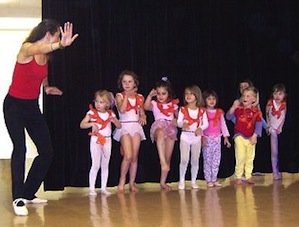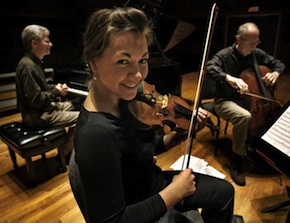Ragazzi Boys Chorus: Unite the Streets

When we reached Colston Rienhoff, a singer with the Ragazzi Boy’s Chorus, he said he was 13, but by his tone and aplomb, he seemed much older — about the age and refinement of a retired communications director.
“I’m very excited about this concert,” he said, “All these kids collaborating, it will be an amazing experience.”
He was referring to the final concert of the season, “Street Symphonies” on June 2 at the Trinity Presbyterian Church in San Carlos. Show time is 7 p.m. The concert features various musical traditions, but also a 20-minute collaboration with the Destiny Arts Center, an organization in Oakland that offers classes in martial arts, dance, theater, and youth leadership.
Hip-hop dancers from Destiny will interpret classical music sung by Ragazzi. The music will be Schubert, sung in German.
Rienhoff has been with Ragazzi for five years and attends the North Star Academy, a school for high achievers in Redwood City. Asked whether he listened to hip-hop music himself, he replied, “I find the beauty of classical music much more relaxing, hip-hop can be very jarring to the ear.”
The conversation turned to performances and what audiences may not pick up on.
“I’m not sure they feel the adrenalin when we sing these high notes. It’s just an amazing feeling to project that much sound.”
In addition to the collaboration the concert will feature Native American and African music, and some Michael Jackson.
The Ragazzi chorus includes 170 singers of which 70 will perform on Saturday. Most are in the 6th and 7th grades. The chorus, often listed among the top five children’s choruses in the bay area, is lead by, and co-founded by, Joyce Weil 25. She comes from a background in psychology, which she studied at Occidental College and then at the New School in New York.
“Our interest in this concert is showing unity between disparate forms,” notes Weil.
Give Kids Dance and Give Them Courage

Imagine an 8-year-old girl suffering from Selective Mutism. Not to be confused with certain forms of Autism or Attention Deficit Disorder, it is an extreme form of shyness, a kind of linguistic cage: Selective is the key word. And so this particular girl leads two lives. At home she is talkative and outgoing. She also plays the piano. But beyond the front door, and away from family and friends, she may suddenly become overwhelmed with anxiety, and a ‘phobia of being heard,’ as her mother puts it. Sometimes, much as she might want to, the girl literally cannot speak. Or else, she says only what is absolutely required.
The ignition for onset of the condition is often at school or in some situation where there is an expectation of speaking.
But then how to explain what happens when one day this girl finds herself standing behind a stage curtain, in complete darkness. She’s terrified on several levels ... and remember, she’s 8. The curtain rises, there’s a blast of light and suddenly she’s feels, as she would say later, “peaceful.” Peaceful, and playing the part of Maria in an adaptation of West Side Story. Fast forward and now she’s now set for the lead in Anything Goes.
Welcome to Kids ‘N Dance, which has been chosen “Family Favorite Award Winner” in seven out of the last nine years. The program, which has studios in Oakland and Lafayette, was started by Kris Mueller who is dedicated to the proposition that dance can be a catalyst for building self-esteem and self-expression.
“What makes us unusual,” says Ms. Mueller, who has been teaching theater for 20 years, “is first, we take anybody, there are no auditions. To put on a show we rehearse once a week for an hour. For 12 weeks. One dress rehearsal. It’s very concentrated. Teachers are highly trained to do this, and that’s why it works. The other thing I try to do is to give everybody a good part. No one is just chorus or a lead. Everyone has lines, and everyone gets a chance get more lines as they become more confident.”
Staying Grounded With Ariana Kim

Mark your calendars for 8 p.m. on June 2 for the Palo Alto Chamber Orchestra at Cubberley Theater. The program includes Ariana Kim, 29, the wunderkind violinist whose resume includes — besides honor upon honor — an education at the San Francisco Conservatory of Music and Juilliard, where she recently received her PhD in Musical Arts. In the fall, she will join the music faculty at Cornell. She was in the air between New York and San Francisco when we reached her earlier this week by email, for a brief interview.
For you, what is the art of playing in a chamber orchestra, as opposed to a symphony or some other grouping?
One of the great pleasures of playing in a chamber orchestra, particularly a string chamber orchestra (as opposed to a larger symphony orchestra), is that the ensemble has the ability to function much more like a string quartet, and can approach it from a chamber music perspective. With small numbers, there is room for flexibility, a heightened sense of communication, and subtle, spontaneous interactions between the sections.
When you play this piece scheduled for this weekend, the Bach Violin Concerto in E Major, what do you think about?
For me, Bach's E-Major Violin Concerto immediately summons true and utter joy. The very first notes of the piece simply outline an ascending E-Major triad, yet somehow create a beautiful sense of uplifted exuberance. The final movement follows suit, alternating a jubilant ritornello passage with four differing variations, always bringing the listener "home" to a place of jubilation. The middle movement, for me, is a tender and meaningful meditation. I always imagine being transported into a different world, a different time when performing the piece.
If you were not a musician, what career would you choose?
Up until I was 6, I wanted desperately to be a milk truck driver! I was inspired by a Sesame Street segment and told everyone that this was my career plan. Obviously that didn't pan out, and if I were to do something else ... perhaps I would be a chef (I live to eat!) or a kindergarten teacher.
You are one of the most respected young artists of your generation; is there anything you can say about the difference between your generation and older generations. For example, is there a difference in the way yours approaches music?
I'm still very much a student, and when I have had the great fortune to work with the musical giants of previous generations, I try my best to take part in their wisdom and to preserve the sacred practice of being a servant to the music.
What makes you nervous or uncomfortable when you're playing. And by the same token, when do you know that you're 'in the zone' to pick a sports expression?
Hmm ... for me, nerves and excitement are part of the human experience, and whenever I feel touched by these elements, I always try to go back to the essence of why we do what we do: to communicate the composer's intentions, to the best of our abilities, and in doing so, create art. Although it's easier said than done, I always aim to channel nerves in a positive way, rather than a negative, and trusting in my preparation. In doing so, I find it much easier to be transported. On an aural level, I love listening to the blend of sounds in a new space — performing in different concert halls and having the ability to respond to "what you get back" acoustically is incredibly powerful and can contribute to some wonderful, spontaneous moments in a concert.
